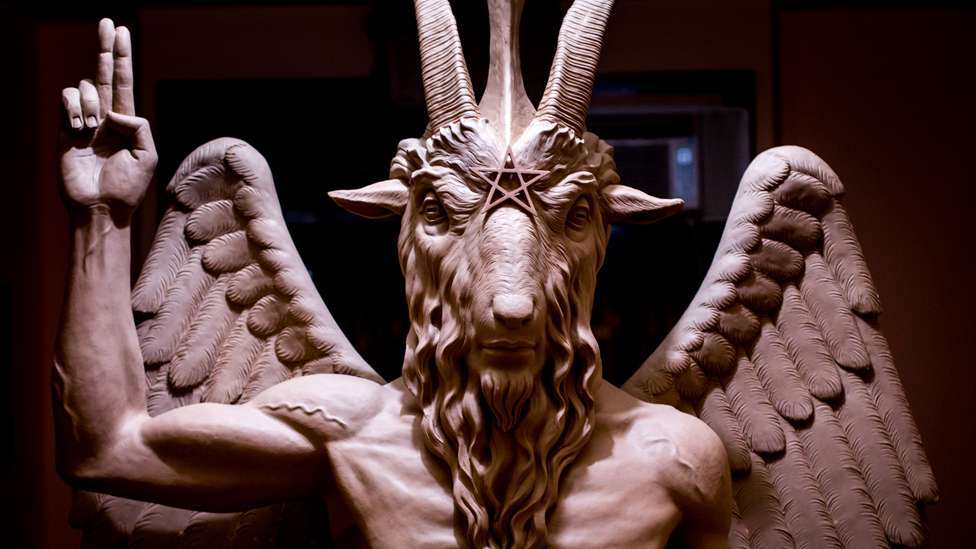
Who is Satan? Bio, Meaning, Age, Pictures, Scriptures, Origin, Evil
Biography
Satan, also referred to as the Devil, is a prominent figure in several religious traditions, particularly in Christianity, Islam, and Judaism.
In Christianity, Satan is commonly seen as a fallen angel named Lucifer, who defied God and was cast out of Heaven. He represents evil, temptation, and opposition to God‘s will, often luring humans into sin.
Trending Now!!:
In Islam, Satan, or Iblis/Shaytan, is a jinn who refused to bow to Adam, resulting in his expulsion from Paradise. In Judaism, the figure of Satan is less personified and is often viewed as an adversary or accuser, testing human faith.
While his role differs across these traditions, Satan is generally depicted as a tempter, accuser, or a symbol of human imperfection and the ongoing battle between good and evil.
Satan | |
|---|---|
 | |
| Wiki Facts & About Data | |
| Real Name: | Satan |
| Stage Name: | Devil, Lucifer, Iblis/Shaytan |
| Born: | Around 550 BCE |
| Place of Birth: | Heaven |
| State Of Origin: | Hell |
| Nationality: | Hell, Heaven |
| Education: | N/A |
| Height: | N/A |
| Creator: | God |
| Siblings: | N/A |
| Spouse: | Not Married |
| Girlfriend • Boyfriend • Partner: | N/A |
| Children: | N/A |
| Occupation: | Ruler of Hell |
| Net Worth: | $??? (USD) |
Early Life
As presented in religious texts, the concept of Satan doesn’t offer a detailed biography in the human sense, as he is a spiritual or mythological figure rather than a historical person. Here’s a summary based on traditional religious narratives:
Satan does not have a human-like birth. In Christian theology, he is described as a created angel, existing from the beginning or the moment of creation. He was not born in the way humans are, but rather, he was an angel made in Heaven.
Ethnicity, a human characteristic, doesn’t apply to spiritual beings such as angels or demons. However, in some interpretations, especially in Christian art and literature, Satan is depicted with dark or varied features to represent his role as the adversary. Satan, across Christian, Islamic, and Jewish traditions, doesn’t adhere to a specific religion; instead, he is often seen as opposing the divine will or testing human faith.
In Christian lore, Satan is considered a being created directly by God, not born from human parents. There is no mention of a “mother” or “father” in his narrative. The idea of siblings is similarly not relevant in the traditional sense, though, before his fall, Satan was part of the host of angels, which could be metaphorically seen as siblings in a spiritual context. There is no formal mention of education, though Satan is depicted as possessing wisdom and knowledge inherent to his nature as an angel rather than acquired through formal learning.
These details are derived from religious texts and interpretations, mainly the Bible, the Quran, and related theological discussions. Since Satan is not a figure with a human biography, much of this is speculative or metaphorical, rather than factual in a traditional sense.
Career
Satan‘s “career” is a matter of interpretation, shaped by religious texts and theological discussions rather than following a conventional career path. Here’s an overview:
Initially, Satan, known as Lucifer or the Morning Star, was one of Heaven’s highest angels, possibly the seraphim’s leader or cherubim, celebrated for his beauty and wisdom. His trajectory took a drastic turn when he rebelled against God, desiring to elevate himself to God‘s level.
This rebellion led to his expulsion from Heaven, transforming him into Satan, the adversary. After his fall, his role became one of opposition to God‘s plans, often depicted as the tempter who leads humanity away from righteousness, as seen in the temptation of Adam and Eve or Jesus in the wilderness. While popular culture and some Christian traditions portray Satan as the ruler of Hell, this is more of a post-biblical development. In scripture, Satan is portrayed as a roaming adversary rather than a ruler of a specific realm.
In Islam, Satan is known as Iblis, a member of the jinn who was initially allowed into Heaven. He was highly respected until he refused to bow to Adam, leading to his curse. After his fall, his role became one of whispering temptations into the hearts of humans, diverting them from Allah‘s path. Unlike the Christian concept of Hell, Iblis is not seen as a ruler of a physical Hell but as an antagonist in human life.
In Judaism, Satan’s role often involves acting as an agent of God, testing the faith and loyalty of humans, as seen in the Book of Job. He is not inherently evil but serves as a prosecutor or challenger.
Across these traditions, Satan‘s “career” involves deception, accusation, and testing human faith or morality. His methods include sowing discord, encouraging pride, and exploiting human weaknesses. His overarching role can be described as opposing divine will or leading humans into sin, whether out of malice or pride or as part of a divine plan for testing faith.
Satan’s portrayal is highly symbolic and varies across different interpretations and religious texts. His “career” is less about a linear progression through various roles and more about his function in the cosmic narrative of good versus evil.
Personal Life
The traditional religious texts from Christianity, Islam, and Judaism do not provide explicit details about Satan having a wife, marriages, or children in the human sense. Here’s a breakdown based on the narratives available:
There’s no mention in the Bible of Satan having a wife or children. However, popular culture and later theological interpretations have sometimes introduced characters like Lilith, who is considered a consort of Satan in some myths, though this is not biblically supported. Some Christian demonologies mention demons or lesser spirits that might be regarded as under Satan’s command or part of his “family” in a metaphorical sense, but these are not children in the biological sense.
The Quran does not discuss Satan (Iblis) having a wife or children. However, Islamic folklore and some Hadith literature mention that Iblis has a wife named al-Zubayyah or that he has progeny called the jinn or shaytan (devils). These are not direct descendants in the human familial structure but rather a class of beings under his influence.
There’s a non-canonical Jewish myth about Lilith, who, in some later interpretations, is seen as a demonic figure and sometimes linked with Satan or Samael (another name for Satan in some texts), though this is folklore rather than scriptural. The Talmud and other texts discuss various demons but don’t establish a familial structure for Satan.
In all these traditions, any mention of Satan having a “family” is highly symbolic or allegorical, representing forces of evil or temptation rather than literal family ties. Many of the ideas about Satan’s family come from post-scriptural literature, folklore, and cultural interpretations rather than from the core religious texts themselves.
Controversies
Satan, as a figure in religious, cultural, and philosophical discourse, has been at the center of numerous controversies. Here are some of the notable ones:
One of the primary debates is whether Satan is a literal being or a symbol of human sin and temptation. Some interpretations argue that Satan represents the darker aspects of human nature rather than an external entity. There’s contention over whether Satan‘s actions are part of God‘s plan or an independent act of rebellion, questioning the nature of free will versus predestination. Debates include whether Satan is still active in the world, tempting humans, or if his role concluded with specific events in scripture.
Over centuries, Satan has been portrayed as a tragic figure (as in Milton’s “Paradise Lost”) or a purely malevolent force. This has led to debates about whether such portrayals humanize or demonize him further. Satan has also been used metaphorically in political discourse, often to demonize opponents, leading to controversies about the moral implications of such comparisons.
The role and nature of Satan differ significantly between Christianity, Islam, and Judaism, leading to interfaith debates. For instance, the Islamic view of Iblis as a jinn contrasts with the Christian view of Satan as a fallen angel. The emergence of various forms of Satanism has caused considerable controversy. There’s confusion between Theistic Satanism, which believes in Satan as a deity, and LaVeyan Satanism, which uses Satan as a symbol of individualism and freedom from religious oppression.
The portrayal of Satan in movies, music, and other media often sparks debate about glorification vs. condemnation, especially when used in horror or as a symbol of rebellion or freedom. Artistic expressions involving Satan often lead to discussions on the limits of free speech, with some works being accused of blasphemy while others are defended as art or social commentary.
Some modern interpretations propose Satan as a figure of moral questioning or even enlightenment, challenging traditional views of good and evil, which has stirred ethical debates about the nature of morality itself. There have been legal controversies where groups identifying with Satanism have fought for religious recognition or the right to perform public rituals, often clashing with public sentiment or law.
These controversies reflect not just theological disagreements but also cultural, philosophical, and political tensions around the figure of Satan, showing how a single symbol can embody a wide range of human concerns, fears, and ideologies.
NOTICE!! NOTICE!! NOTICE!!
DISCLAIMER!! : Every Biography and Content Published On TheCityCeleb are For Knowledge Reason. Don't Hesitate to Reach Out for Any Correction || Suggestion || Copyright!!CORRECT@thecityceleb.com


